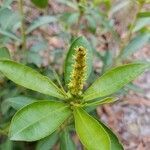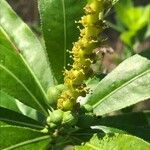Herbs or subshrubs, perennial, with woody rhizome. Stems solitary or fascicled, erect or ascending, mostly unbranched, (1–)2.5–7(–12) dm. Leaves alternate; stipules absent; petiole 0–0.4(–0.8) cm; blade ovate, elliptic, lanceolate, obovate, or oblanceolate, 1–10 × 0.5–-3 cm, base acute or broadly cuneate, margins serrulate to crenulate, teeth without prominent blackened tips, incurved, apex acute, obtuse or rounded; midvein prominent, secondary veins ± obscure. Inflorescences sessile or short-pedunculate, 3–9 cm; staminate cymules ± crowded, 4–7-flowered; pistillate flowers 3–4, crowded; bracts broadly ovate, 1.5 × 2 mm, apex rounded or obtuse, glands patelliform, sessile, 1.5–2 mm diam. Staminate flowers: calyx 1 mm. Pistillate flowers: sepals persistent, 3, well developed, elliptic; styles connate 1/3 length, to 5 mm. Capsules globose, 6–12 mm diam., shallowly 3-lobed; lobes of gynobase 4–6 mm; columella not persistent. Seeds light gray, short cylindric, 4.5 × 3 mm, rugose; caruncle white, broadly crescent-shaped, 1–1.3 mm.
More
Herb 5–10 dm, often emitting a whorl of branches from the base of the primary spike; lvs 3–8 cm; lance-ovate, elliptic, or oblanceolate, serrate with incurved glandular teeth; spikes stout, erect, 5–10 cm, the staminate portion eventually deciduous; staminate fls clustered in the axils of minute bracts, each bract with 2 conspicuous, saucer-shaped glands; fr glabrous, 1 cm. Dry woods; se. Va. to Fla., Tex., and N.M., n. in the interior to Kans. May, June.


